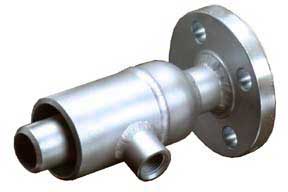Jacketed Piping
In the language of processing systems, jacketed pipes are essentially pipes within pipes. The inner pipe (Core) transports the product, and the outer pipe (Jacket) serves as heating or cooling pipe.
Example..If very dense and viscous product is to be transported from one point to another, it is often necessary to make the product more fluid, and this is often done by heating the product with e.g. steam.
The jacket has inlet and outlet ports for the steam, which is pumped through the jacket to heat the product flowing in the inner pipe.


 Image..flextrol.com
Image..flextrol.comPipe size chart (Inches)
| Core Pipe | Jacket Pipe | Steam Feeder |
| 3/4 | 1.1/2 | 1/2 |
| 1 | 2 | 1/2 |
| 1.1/2 | 3 | 1/2 |
| 2 | 3 | 1/2 |
| 4 | 6 | 3/4 |
| 6 | 8 | 3/4 |
| 8 | 10 | 3/4 |
| 10 | 12 | 3/4 |
Flanges Specifically Designed for Jacketed Piping
Types of Jacketed Piping
Depending on the type of jacketed pipe installation over the core pipe, there are mainly two types of jacketed piping.
- Continuous jacketing: In this type of piping, all straight pipe lengths, including flanges, fittings, valves and branches are fully jacketed.
- Discontinuous jacketing: In this type of pipeline, only straight sections of pipe are jacketed. Branches, fittings and valves are not jacketed.
Design considerations for jacketed pipe systems
Jacketed pipe systems are more complex than standard process piping and require more engineering to ensure that they function properly. A number of considerations must be taken into account when designing and constructing jacketed pipe systems.
Fluid Pressure the fluid flowing into the core pipe should be able to operate at a lower pressure than the fluid flowing into the jacket pipe. This should ensure that in the event of an unseen failure in the process core pipe, the product can be captured in the jacket instead of flowing outside the system.
Locations of media ports the media inlet port for the system should be at the lowest point of the process pipe, and conversely, the outlet port should be at the highest point. This ensures that the media completely fills the jacket pipe before it leaves the system, and does the job for which it is intended.
Slope a jacket piping system should be installed with a certain slope required depending on the density and viscosity of the fluid flowing into the core pipe to ensure that the process fluid is completely drained from the core pipe.
Flow direction of the fluid the flow direction of the fluid in the core and jacket pipe should be opposite to each other. This opposite flow direction offers the advantage of cooling or heating the product flowing into the core pipe at the desired rate.
Continuity breaks and connections a jacketed pipe system should be designed with a minimum number of break flanges and joints. Each break in jacket or core pipe costs more material and more cost to maintain the system.
Annular space between core and jacket when designing the annular space between the core pipe and jacket, the pipe must be optimized to prevent product solidification or scorching of the piping system material.
Stress analysis of jacketed pipe systems as a result of the different operating temperatures and pressures of the core and jacket pipe, stresses may arise in the system that cause the failure of the piping system. Therefore, proper performance of stress analysis of jacketed pipes is considered necessary.
System components and layout
lastly, the following should be considered in the design of the piping system with jacketed pipes
- Thermal difference and expansion between the core and jacket.
- Types of connectors to be used.
- Internal spacers or guide strips between jacket and core pipe.
- Any turbulence mechanisms required in the pipe, such as circuit breakers, fins and windings.
- The corrosion potential of both core and jacket pipe must be considered.

